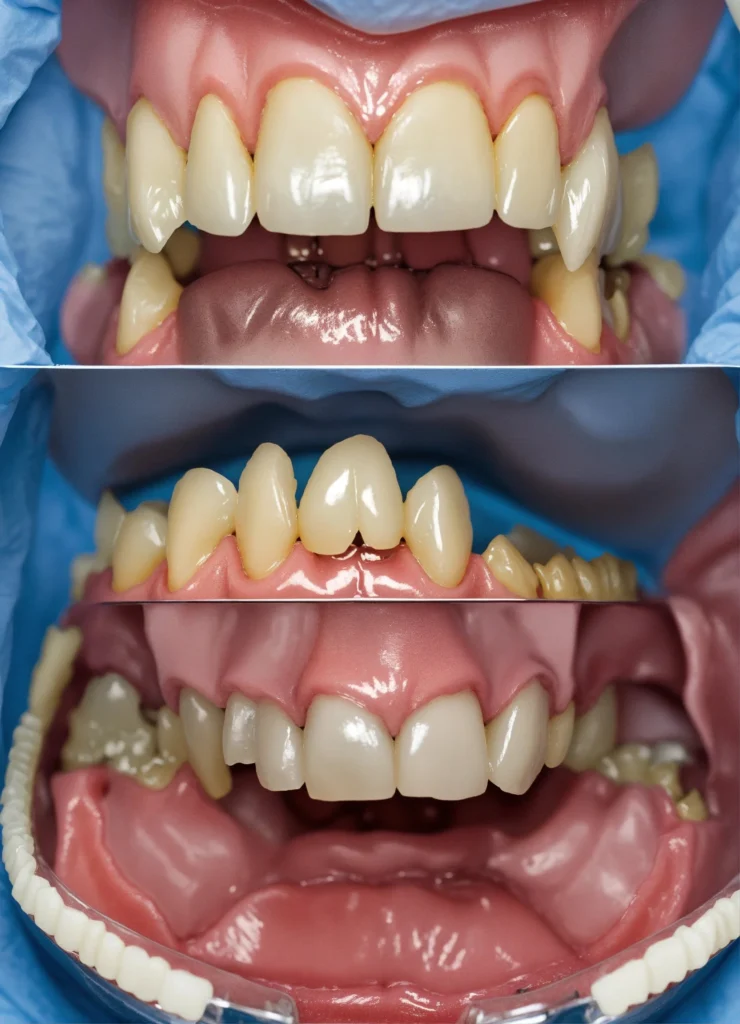
Gum disease is a common oral health condition that affects the gums and bones that support the teeth. It can range from mild gum inflammation (gingivitis) to more severe conditions like periodontitis, which can result in tooth loss if not treated properly. Oral health is a crucial part of overall well-being, and understanding gum disease staging and grading
Gum Disease Symptoms Include Diagnosis, Treatment, and Prevention.
Maintaining a healthy lifestyle is essential. This article aims to educate readers on the causes, symptoms, and treatment of gum disease, offering both traditional and natural remedies, as well as preventative tips to ensure a long-lasting, healthy smile.
What is Gum Disease?
Gum disease, also known as periodontal disease, is an infection of the tissues that surround and support your teeth. Poor oral hygiene primarily causes it by allowing plaque, a sticky film of bacteria, to build up and harden on the teeth. Over time, this can lead to inflammation of the gums (gingivitis) and, if left untreated, more severe conditions like pyorrhea or periodontitis.
There are two Main Types of Gum Disease:
Gingivitis: The earliest stage of gum disease, characterized by red, swollen gums that bleed easily. Gingivitis is reversible with proper oral care.
Periodontitis: A more serious form of gum disease in which the inner layer of the gums pulls away from the teeth, forming pockets that can become infected. If untreated, periodontitis can destroy the bone that supports the teeth, leading to tooth loss.
How Common is Gum Disease?
Gum disease is extremely common, especially among adults. According to the CDC, nearly 50% of adults over the age of 30 have some form of periodontal disease, with the risk increasing with age.
Gingivitis vs. Periodontitis
Understanding the difference between gingivitis and periodontitis is key to early detection and treatment. Gingivitis, a mild form of gum disease, solely impacts the gums and is reversible. However, if left untreated, gingivitis can progress to periodontitis, which is more severe and can lead to irreversible damage, including tooth loss.
Causes of Gum Disease

Poor Oral Hygiene
The most common cause of gum disease is poor oral hygiene, which allows plaque to accumulate on the teeth. Plaque is full of bacteria that can irritate the gums and lead to inflammation, causing gingivitis.
Diet and Nutrition
Diet plays a significant role in oral health. Foods high in sugar and refined carbohydrates contribute to the growth of plaque-forming bacteria. Additionally, deficiencies in essential nutrients like vitamin C can weaken gum tissues and increase the risk of gum disease.
Smoking and Tobacco Use
Smoking and using tobacco products can severely damage gum tissue and hinder its healing ability. Studies show that smokers are significantly more likely to develop gum disease than non-smokers. Even smokeless tobacco products, like Zyn pouches, can be hazardous for your gums as they contain nicotine and other harmful chemicals.
Hormonal Changes
Hormonal changes, such as those experienced during pregnancy, menopause, or menstruation, can make gums more sensitive and vulnerable to inflammation and gum disease.
Genetics
Some people are genetically predisposed to gum disease. If gum disease runs in your family, you might be at a higher risk even with good oral hygiene habits.
Underlying Health Conditions
Certain medical conditions, such as diabetes and autoimmune disorders, can increase the likelihood of developing gum disease. Diabetics, in particular, are more prone to infections, including those affecting the gums.
Gum disease symptoms
- Early-Stage Symptoms (Gingivitis)
- Red, swelling, or tender gums
- Bleeding gums, especially when brushing or flossing
- Bad breath (halitosis)
- Advanced-Stage Symptoms (Periodontitis)
- Receding gums
- Loose or shifting teeth
- Pus between gums and teeth
- Pain while chewing
- Gaps developing between teeth
Diagnosis

The diagnosis of gum disease typically involves a dental exam, where the dentist checks for signs of inflammation, receding gums, and any movement of the teeth. The dentist commonly uses X-rays and periodontal probing to assess the extent of damage and bone loss.
Self-Checks and Early Warning Signs
Regularly checking your gums at home for any redness, swelling, or bleeding can help detect gum disease early. If you notice persistent foul breath or receding gums, it’s important to seek professional care.
Perio Staging and Grading
When diagnosing periodontal disease, dentists use a system called periodontal staging and grading. Perio staging and grading assist in determining the disease’s severity and rate of progression. This entails assessing the depth of gum pockets, the amount of bone loss, and any other risk factors, such as smoking or diabetes.
Treatment Options
Home care and prevention
Prevention is the best method for treating gum disease. Proper brushing and flossing techniques are essential to remove plaque and prevent gum disease. Using a good toothpaste specifically designed for gum health can also help. So, what is the best toothpaste for gum disease? We highly recommend toothpastes that contain fluoride, antibacterial agents, and natural ingredients like tea tree oil.
Additionally, using natural remedies, such as essential oils like tea tree or clove oil, can reduce inflammation and kill bacteria. Homemade mouthwashes with salt water or herbal infusions are also effective at maintaining gum health.
Professional Cleaning
When home care isn’t enough, professional cleaning is necessary. Scaling and root planing, also known as deep cleaning, is a procedure that removes plaque and tartar from below the gum line. This can prevent further damage and help the gums heal.
Medications
A dentist may recommend antibiotic gels, mouth rinses, or other prescription medications to reduce bacteria and inflammation. For more advanced cases of gum diseases, dentists often combine these treatments with deep cleaning.
Surgical Treatments
Surgery may be required in severe cases to repair periodontitis-related damage. Common procedures include
- Flap Surgery: The gums are lifted back to remove tartar deposits.
- Bone Grafts: Used to replace damaged bone, promoting regrowth and stabilizing the teeth.
- Tissue Grafts: When gum tissue has receded, tissue grafts can help restore the gums to their original position.

Natural and holistic remedies
In addition to professional treatments, many people seek out natural remedies to cure gum disease. One of the most common questions is how to cure gum disease without a dentist. Professional care is crucial for severe cases, but with proper care and the use of natural remedies, one can often manage mild gum disease at home. Herbal remedies like turmeric, aloe vera, and green tea are known for their anti-inflammatory properties and can help maintain gum health.
Prevention Tips
Daily Oral Hygiene: Brushing twice a day with fluoride toothpaste and flossing daily are the most effective ways to prevent gum disease.
- Regular Dental Checkups: Visiting the dentist at least twice a year for cleanings and exams can catch gum disease early before it progresses.
- Healthy Diet: Eating a diet rich in fruits and vegetables, particularly those high in vitamin C and antioxidants, supports gum health.
- Avoid Smoking: Nicotine is one of the leading causes of gum disease. Quitting smoking can significantly improve oral health and prevent the progression of gum disease.
- Stress Management: High levels of stress can weaken the immune system, making it harder for your body to fight off infections, including gum disease.
- Complications if Left Untreated
- Untreated gum disease can result in serious complications, including:
- Tooth Loss: As the gums and bones deteriorate, teeth can become loose and eventually fall out.
- Systemic Health Issues: Studies have linked gum disease to several systemic conditions, such as heart disease, stroke, and respiratory disease. It’s important to understand that gum disease can kill you indirectly by contributing to these life-threatening conditions.
- Pregnancy Complications: Pregnant women with gum disease are at a higher risk of giving birth prematurely or having a low birth-weight baby.
- With Periodontal Disease, How Long Can You Keep Your Teeth?
- With proper treatment and care, it’s possible to keep your teeth even with advanced periodontal disease. Early intervention is key, and with good oral hygiene and regular dental visits, many people are able to keep their natural teeth for life.
Conclusion
Gum disease is a prevalent but preventable condition. By understanding gum disease symptoms, diagnosis, treatment, and prevention, you can take the necessary steps to maintain your oral health. Whether you opt for traditional dental treatments or natural remedies, early detection and consistent care are essential to preventing and treating gum disease. Remember, taking good care of your gums will benefit your entire body, as your oral health closely links to your overall health.


